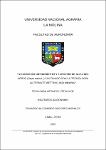Mostrar el registro sencillo del ítem
Análisis del rendimiento y consumo de agua del arroz (Oryza sativa L.) cultivado con la tecnología Alternate Wetting and Drying
| dc.contributor.advisor | Heros Aguilar, Elizabeth Consuelo | |
| dc.contributor.author | Dolores Morales, Eduardo Alejandro | |
| dc.date.accessioned | 2023-09-08T19:47:51Z | |
| dc.date.available | 2023-09-08T19:47:51Z | |
| dc.date.issued | 2023 | |
| dc.identifier.uri | https://hdl.handle.net/20.500.12996/5968 | |
| dc.description | Universidad Nacional Agraria La Molina. Facultad de Agronomía. Departamento Académico de Fitotecnia | es_PE |
| dc.description.abstract | El cultivo de arroz tiene una gran importancia en la alimentación básica del Perú. Uno de los grandes retos de la producción de arroz es mejorar el ahorro del agua y optimizar rendimientos. La Alternancia de Mojado y Secado o “Alternate Wetting and Drying” (AWD) es una técnica de irrigación que consiste en usar menos cantidad de agua alternando periodos secos en el riego. El presente trabajo se realizó en la Estación Experimental Vista Florida del Instituto Nacional de Innovación Agraria (INIA), Lambayeque, en la campaña correspondiente del año 2020 – 2021, con los objetivos de poder contribuir a la reducción del uso de agua y analizar el efecto de esta técnica sobre el crecimiento y rendimiento del cultivo. Evaluamos tres tratamientos de riego: (1) Sistema de inundación permanente, (2) AWD con un descenso del nivel de agua de 5 cm por debajo de la superficie del suelo y (3) AWD con un nivel de agua de 10 cm por debajo de la superficie del suelo. En general, el sistema de inundación permanente tuvo el más alto rendimiento logrando 8.7 t/ha; sin embargo, el tratamiento AWD – 5 cm pudo reducir 10.9 % de consumo hídrico y mantener el 87 % del rendimiento de inundación permanente (8.7 t/ha). El número de macollos por metro cuadrado y el número de panículas por metro cuadrado fueron las variables más afectadas por los tratamientos de AWD. La productividad del agua fue igual para los tres sistemas. Concluimos que, bajo nuestras condiciones, la técnica AWD promete el ahorro de agua y más investigación debe realizarse para minimizar la reducción del rendimiento. | es_PE |
| dc.description.abstract | Rice production has a great significance in Peru´s basic diet. One of the big challenges of rice production is to improve water saving while optimizing yield. Alternate Wetting and Drying (AWD) is an irrigation practice that consists on reducing water consumption by alternating dry and wet cycles on irrigation. In this work; carried out at the Vista Florida Experimental Station of the Instituto Nacional de Innovación Agraria - INIA (National Institute of Agrarian Innovation), Lambayeque, during the growing season of 2020 – 2021; the objectives stablished were to contribute to water saving rice production and to analyze the effect of AWD in rice growth and yield. We evaluated three irrigation treatments: (1) continuous flooding (CF), (2) AWD with 5 cm of field water level below the surface and (3) AWD with 10 cm of field water level below de surface. Overall, continuous flooding system had the highest yield compared to both AWD systems, reaching 8.7 t/ha; yet the AWD – 5 cm treatment reduced water consumption in 10.9% and managed to obtain 87% of CF yield. Number of tillers formed per square meter and the number of panicles formed per square meter were most the variables most affected by AWD treatments. On the other hand, water productivity was the same on the three systems as no difference were observed. We concluded that, with our current conditions in production, Alternate Wetting and Drying is a promising technique that can save water usage and more research needs to be done in order to minimize yield reduction. | es_PE |
| dc.format | application/pdf | es_PE |
| dc.language.iso | spa | es_PE |
| dc.publisher | Universidad Nacional Agraria La Molina | es_PE |
| dc.rights | info:eu-repo/semantics/openAccess | es_PE |
| dc.rights.uri | https://creativecommons.org/licenses/by-nc-nd/4.0/ | es_PE |
| dc.subject | Arooz | es_PE |
| dc.title | Análisis del rendimiento y consumo de agua del arroz (Oryza sativa L.) cultivado con la tecnología Alternate Wetting and Drying | es_PE |
| dc.type | info:eu-repo/semantics/bachelorThesis | es_PE |
| thesis.degree.discipline | Agronomía | es_PE |
| thesis.degree.grantor | Universidad Nacional Agraria La Molina. Facultad de Agronomía | es_PE |
| thesis.degree.name | Ingeniero Agrónomo | es_PE |
| dc.subject.ocde | https://purl.org/pe-repo/ocde/ford#4.01.07 | es_PE |
| renati.author.dni | 74689298 | es_PE |
| dc.publisher.country | PE | es_PE |
| dc.type.version | info:eu-repo/semantics/publishedVersion | es_PE |
| renati.advisor.orcid | https://orcid.org/0000-0002-0179-3124 | es_PE |
| renati.advisor.dni | 08273091 | es_PE |
| renati.type | https://purl.org/pe-repo/renati/type#tesis | es_PE |
| renati.level | https://purl.org/pe-repo/renati/level#tituloProfesional | es_PE |
| renati.discipline | 811036 | es_PE |
| renati.juror | Casas Díaz, Andrés Virgilio | |
| renati.juror | Blas Sevillano, Raúl Humberto | |
| renati.juror | Ramos Fernández, Lía |
Ficheros en el ítem
Este ítem aparece en la(s) siguiente(s) colección(ones)
-
AGR-FT Tesis [260]





